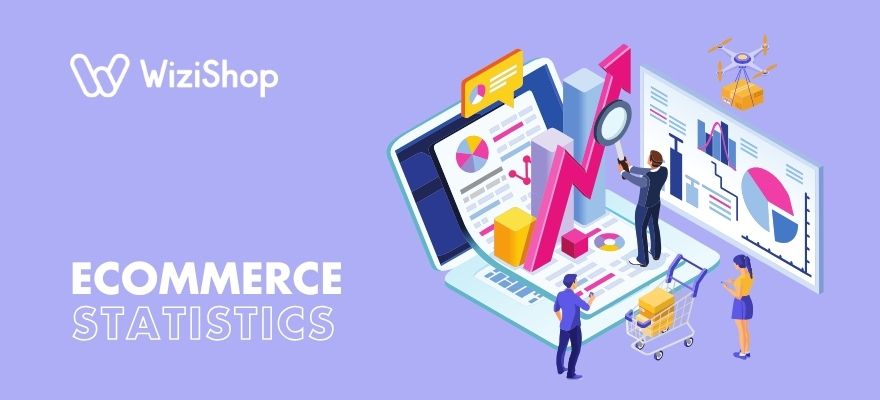Regardless of if you’re new to ecommerce or much more experienced when it comes to owning an online store, you’ve probably discovered that it’s an ever-evolving industry.
It’s therefore advantageous to keep up to date with the current statistics, including all the latest news, trends, and technology to ensure that you provide your customers with the best experience possible and stay ahead of the competition.
In this article, we share some of the most important ecommerce statistics that can assist you in perfecting your business strategy.
Whether you are mainly interested in ecommerce in the USA or want to know all about the top countries buying online, having a decent understanding of what’s going on in web commerce around the globe can help you increase your online store’s success in the upcoming year and beyond.
General state of the global ecommerce industry
Global ecommerce sales are predicted to reach $6.419 trillion in 2025
The arrival of COVID-19 transformed the way that many retailers operated and consumers shopped globally.
With many restrictions in place, ecommerce had a surge in popularity, as people were either required or simply preferred to purchase goods from the comfort of home instead of venturing out to brick-and-mortar stores.
Despite the relaxation of pandemic-related restrictions throughout most of the world, ecommerce continues to flourish.
Global online retail sales were $6.007 trillion in 2024 and are expected to grow approximately 6.8% in 2025. Furthermore, ecommerce sales around the world aren’t likely to decrease anytime soon and are predicted to amount to $7.886 trillion by 2028.
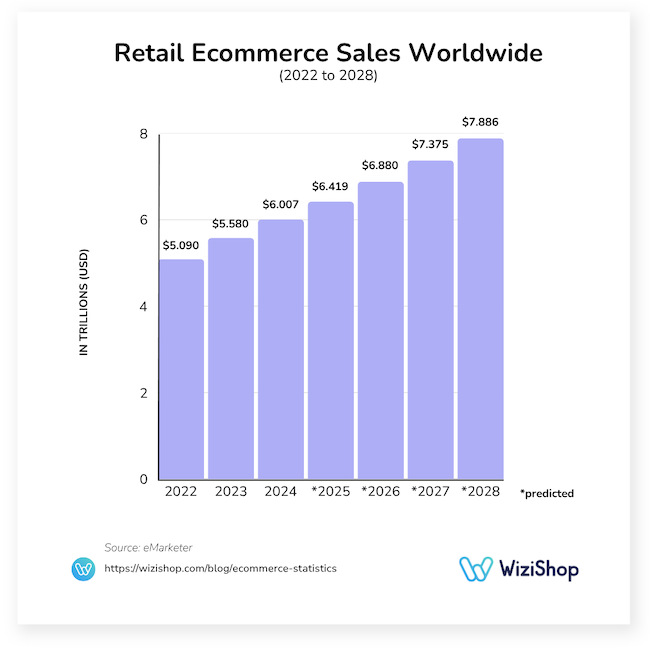
The following chart details the growth of retail ecommerce sales worldwide in the past few years in terms of the percentage increase compared to the previous year, along with estimated increases for the future:
| Year | Ecommerce sales increase (%) compared to previous year |
|---|---|
| 2022 | 5.9% |
| 2023 | 9.6% |
| 2024 | 7.7% |
| 2025 | 6.8% |
| 2026 | 7.2% |
| 2027 | 7.2% |
| 2028 | 6.9% |
Source: eMarketer
Ecommerce sales are forecast to make up more than 20% of total global retail sales in 2025
While it’s clear that physical commerce is still very crucial when it comes to retail revenue, the growing importance of ecommerce around the world can’t be denied.
Consider the following statistic: ecommerce sales made up only 7.4% of global retail sales in 2015 but are expected to almost triple in size 10 years later, accounting for 20.5% of retail sales in 2025.
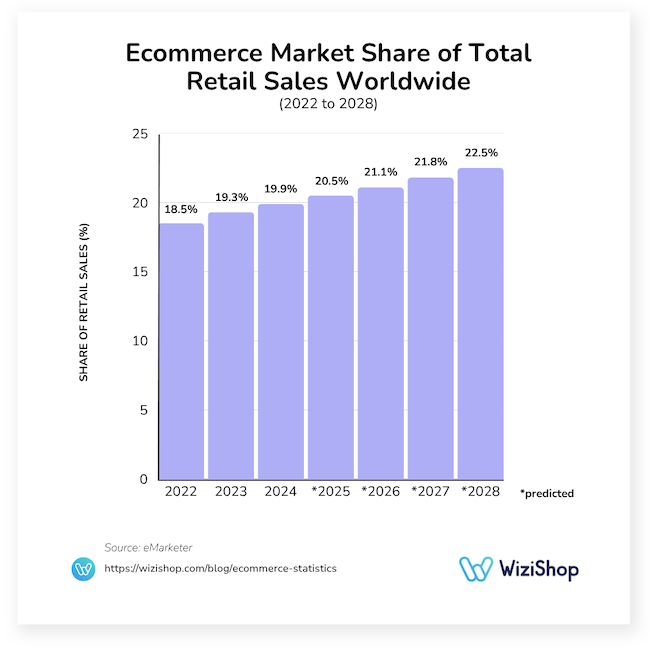
This is great news for people who are considering launching their very own online stores!
However, knowing the percentage of retail sales that occur online is also a helpful statistic for owners of brick-and-mortar shops to keep in mind.
If they don’t yet have a professional, functioning ecommerce site, it’s a good time to start working on building their online presence.
Based on eMarketer’s data, the percentage of global retail sales originating from the internet is likely to continue trending upwards and is expected to reach 22.5% by 2028.
China is #1 when it comes to ecommerce sales
In terms of which country generates the greatest amount of ecommerce revenue around the world, China takes first place, bringing in over $3 trillion in 2024.
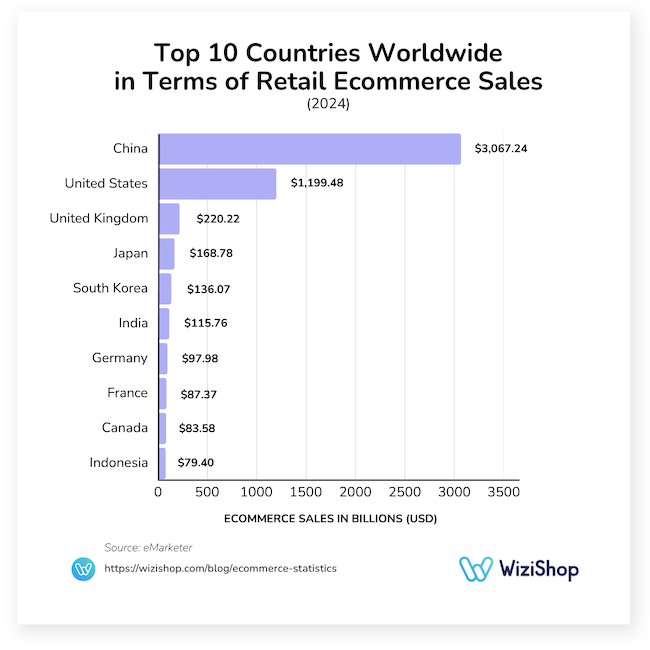
This is followed by the United States, which generated just under $1.2 trillion in 2024, less than half of China’s total sales. The United Kingdom was #3 regarding ecommerce earnings in 2024, coming in at $220.22 billion.
China is responsible for almost half of the global ecommerce market
When looking at the countries generating the most ecommerce sales around the world, we see that the top 5 (China, the United States, the United Kingdom, Japan, and South Korea) together bring in approximately 75.6% of global earnings.
China, however, has by far the largest share, earning 48.8% of worldwide ecommerce market sales.
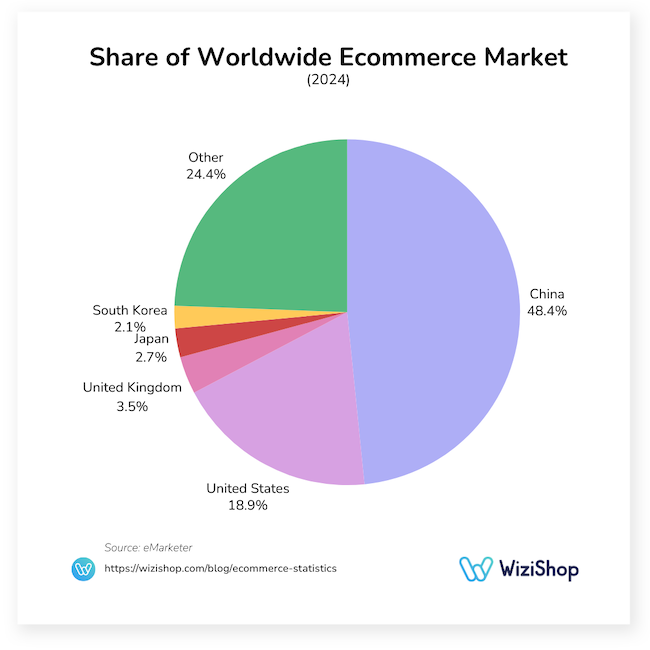
China is also the country with the highest share of retail sales occurring online
In 2023, ecommerce accounted for 47% of China’s total retail revenue.
Rounding out the top 3 in this category were Indonesia and the United Kingdom, with 31.9% and 30.6% of their total retail revenue coming from ecommerce respectively.
| Country | Ecommerce share of retail sales (%) |
|---|---|
| China | 47.0% |
| Indonesia | 31.9% |
| United Kingdom | 30.6% |
| South Korea | 30.0% |
| United States | 15.8% |
| Mexico | 14.2% |
| Singapore | 14.0% |
| Japan | 13.7% |
| Russia | 13.2% |
| Canada | 11.7% |
Source: MobiLoud
The Philippines is the fastest-growing ecommerce market in the world
As of 2023, Asia, Australia, and the Americas saw the most growth in terms of ecommerce sales around the globe. The Philippines had the greatest amount of growth, with online sales increasing 24.1% by the end of the year.
India and Australia hold the #2 and #3 positions, with ecommerce growth of 22.3% and 20% respectively. Mexico takes the leading spot for the Americas, with an ecommerce growth rate of 14.2%, while Argentina comes in just behind at 14%.
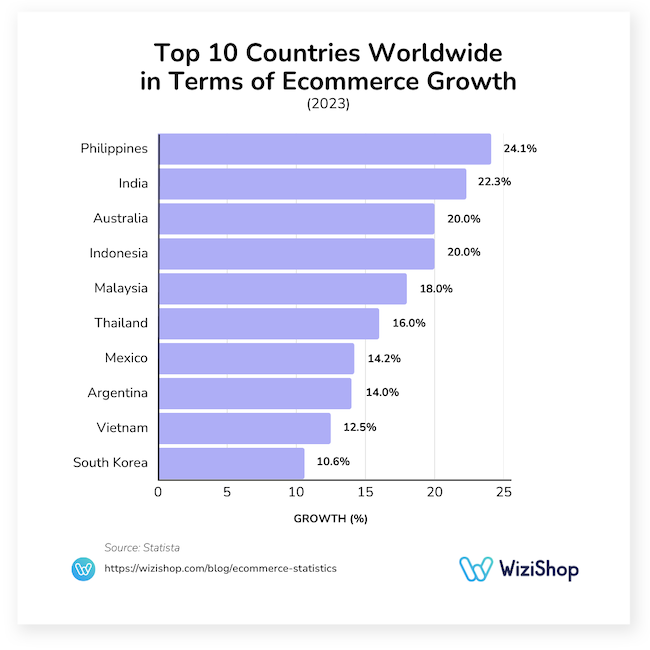
Depending on where you’re based and your specific products/services, it may be interesting to think about targeting these areas to boost sales for your online store.
Electronics is the #1 segment in the global ecommerce market
Today, consumers shopping on the web can find all kinds of online stores, selling nearly any product imaginable. However, it’s important to note that some types of goods tend to sell better than others online, for various reasons.
In 2023, electronics took the #1 spot around the world regarding ecommerce market segments, accounting for approximately 23% of worldwide ecommerce revenue.
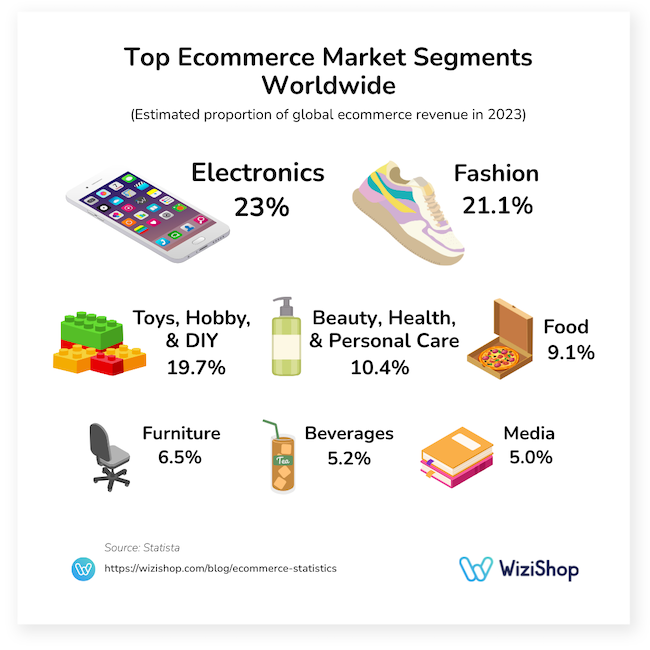
If you’re considering creating your own ecommerce site but don’t yet know what you want to sell, the electronics universe may very well be a good place to start.
It’s worth noting, though, that the segments of fashion as well as toys, hobby, and DIY are close behind, generating 21.1% and 19.7% of the world’s ecommerce revenue respectively.
The sector predicted to have the most revenue growth in upcoming years is food and personal care
Although electronic goods currently produce the most ecommerce revenue, food and personal care products are expected to see the biggest growth in global sales in the next few years. Analysts estimate that this sector will grow 64.2% from 2020 to 2025, earning a forecasted $791.6 billion by 2025.
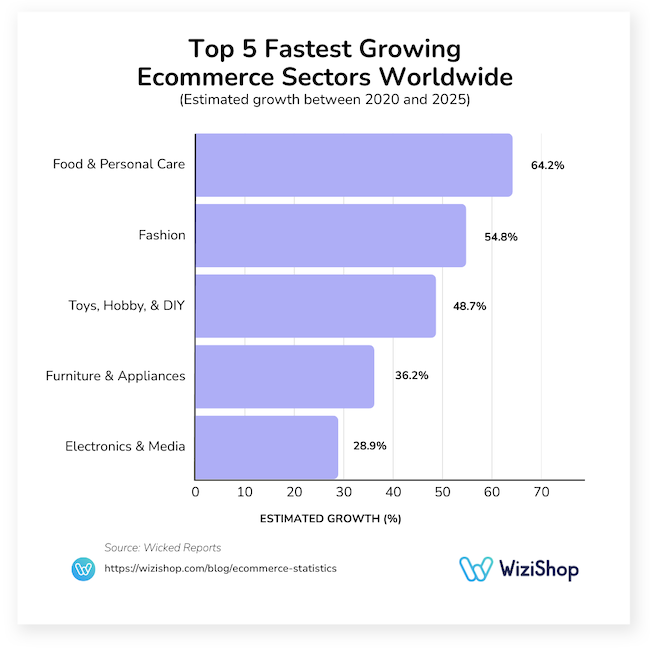
Looking back in recent history, it’s not difficult to see why the “food and personal care” sector is experiencing significant growth.
While the shift to purchasing goods in this category began several years back, COVID-19’s arrival skyrocketed this buying behavior, as people, motivated by health concerns and lockdown restrictions, began shopping for groceries and personal hygiene products like toilet paper on the internet.
Today, many shoppers continue to appreciate the added convenience of ecommerce and prefer to purchase essential goods online.
Although food and personal care is the sector expected to experience the most growth, it’s actually the fashion sector that’s likely to generate the most money, with estimated revenue of $1.2 trillion in 2025.
The following table lists the predicted global revenues for the rest of the aforementioned fastest growing ecommerce sectors:
| Ecommerce sector | Predicted global revenue (USD) in 2025 |
|---|---|
| Fashion | $1.2 trillion |
| Toys, hobby, & DIY | $946.4 billion |
| Food & personal care | $791.6 billion |
| Electronics & media | $773.9 billion |
| Furniture & appliances | $521.9 billion |
Source: Wicked Reports
Ecommerce marketing
Search engines are the top source of brand discovery
Thinking about letting your SEO efforts fall by the wayside? If so, I strongly urge you to reconsider!
According to DataReportal’s February 2025 report, search engines are the most popular source of brand discovery for internet users worldwide, with 32.8% of survey respondents stating that they use this method for discovering new brands.
And while respondents were able to select one more response for this particular survey question, it’s clear that optimizing your ecommerce website to work on climbing the rankings on search engines like Google is still very much an essential task when it comes to achieving success in web commerce.
A well-rounded SEO strategy includes a variety of actions. However, it may interest you to know that when you create your ecommerce store on the WiziShop platform, you’ll get to enjoy 50+ pre-integrated features to boost your website’s technical SEO. We take care of this all-important aspect for you, with no extra effort on your part required!
Try WiziShop free for 7 days
THE EASIEST NO-CODE ECOMMERCE SOLUTION✅ No credit card required
✅ Access to all features
✅ No commitment
When it comes to helping potential customers discover your brand, products, and/or services, you might be interested to learn that besides online searches, TV ads were another favorite among survey respondents, with 32.3% of them choosing this strategy.
Word of mouth, social media ads, and brand websites all followed closely behind, with 29.9%, 29.7%, and 25.8% of respondents picking these options respectively.
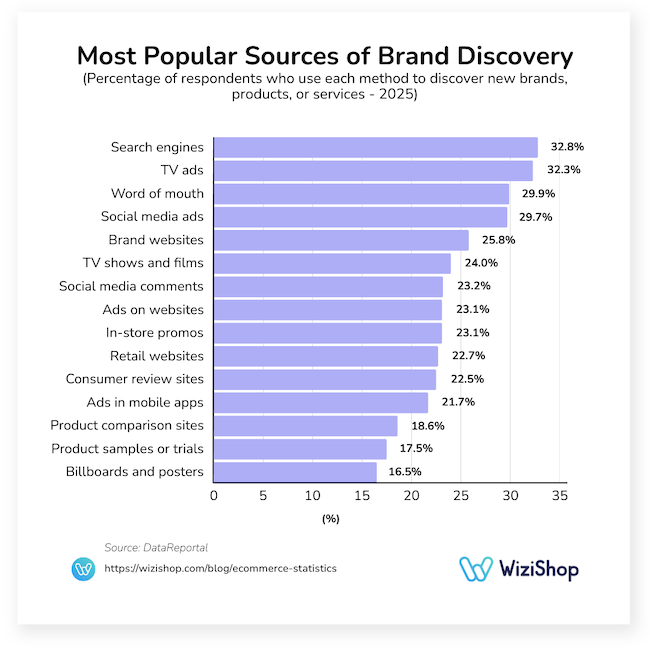
The size of the global influencer marketing market has more than tripled since 2019
Influencer marketing is one of today’s most prevalent marketing strategies used by brands all around the world.
Consider that while the global influencer marketing market size was valued at $6.5 billion in 2019, it’s grown approximately 369% since then, amounting to $24 billion in 2024, and it’s predicted to reach about $32.6 billion in 2025!
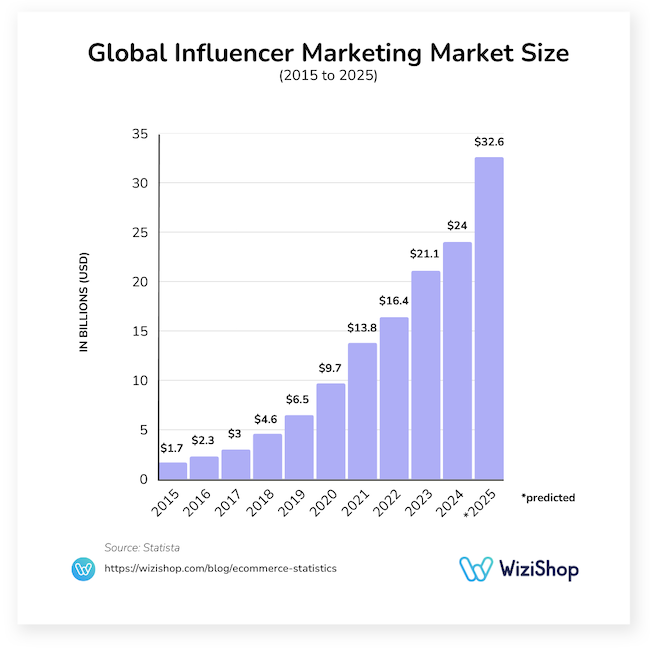
In the table below, you can see how much this market has increased in recent years in comparison to the previous year, as well as predicted growth for 2025:
| Year | Influencer marketing market size increase (%) compared to previous year |
|---|---|
| 2016 | 35.3% |
| 2017 | 30.4% |
| 2018 | 53.3% |
| 2019 | 41.3% |
| 2020 | 49.2% |
| 2021 | 42.3% |
| 2022 | 18.8% |
| 2023 | 28.7% |
| 2024 | 13.7% |
| 2025 | 35.8% |
Source: Statista
This leading digital marketing tactic is very effective due to the trust that the influencer has built up with their audience.
A brand will seek out an influencer well known in a specific niche with whom to collaborate. In exchange for money or free goods, the influencer will then promote the brand’s product or service to their audience on social networks or another platform, such as a blog.
Have a relatively new ecommerce business? Note that marketers with a smaller budget on hand can still find lots of success working with influencers—you don’t need to hire a world-famous celebrity!
In fact, one of the most prominent ecommerce marketing trends now involves brands partnering with nano- or micro-influencers (those with around 1K to 10K followers and 10K to 50K followers respectively). Besides usually charging lower fees, these levels of influencers tend to have more engaged, better targeted audiences.
Annual global spend on social media advertising increased 150% from 2019 to 2024
With the growing number of social network users browsing the different platforms in their free time, it’s not surprising that brands are increasingly taking advantage of social networks to promote their products and/or services.
In fact, annual global spend on social media advertising grew by $146.5 billion in a 5-year time period, reaching $244 billion in 2024.
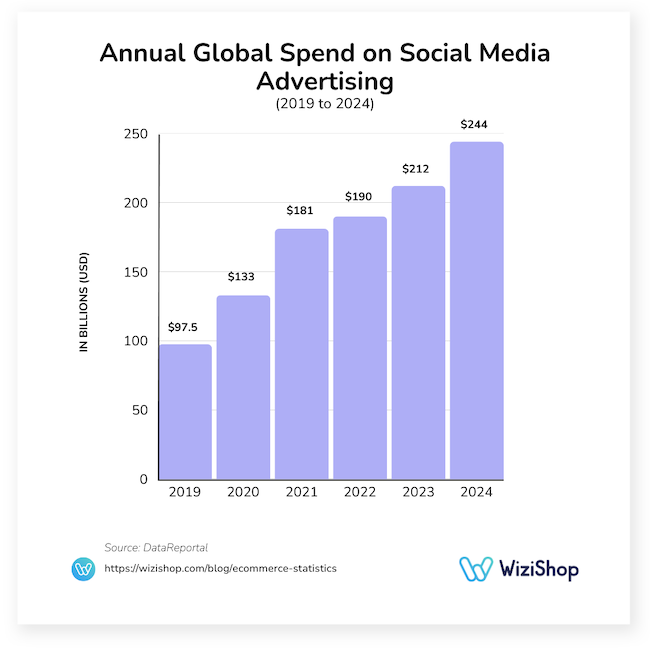
The table below indicates how much recent spending on social media advertising increased in terms of percentage compared to the previous year:
| Year | Increase (%) in spending on social media ads compared to previous year |
|---|---|
| 2020 | 36.4% |
| 2021 | 36.1% |
| 2022 | 5.0% |
| 2023 | 11.6% |
| 2024 | 15.1% |
Source: DataReportal
If you have a new ecommerce store, investing in paid advertising may not yet be a priority, depending on your financial situation. Nevertheless, it’s something you’ll definitely want to keep in mind as your business grows and your marketing budget becomes more flexible.
The United States has the highest average social media ad spend per user
The United States leads the way when it comes to average social media ad spend, investing $335 per user on average for advertising on social networks, followed by the United Kingdom and Australia, who spend $207 and $204 respectively per user on average.
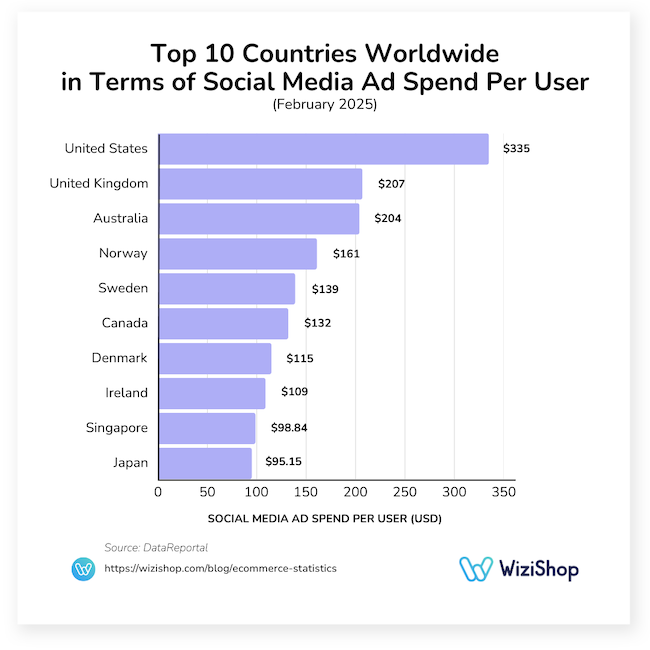
It’s interesting to note that these figures are quite a bit higher than the global average, which is reported to be $46.47 per user.
Facebook is the favorite platform for social commerce in the US
Today, we can’t talk about social media and ecommerce without mentioning social commerce, the use of social networks to facilitate ecommerce transactions.
Although multiple platforms offer social commerce capabilities, Facebook is the most used option in the US, with 69.4 million people predicted to shop on the network in 2025.
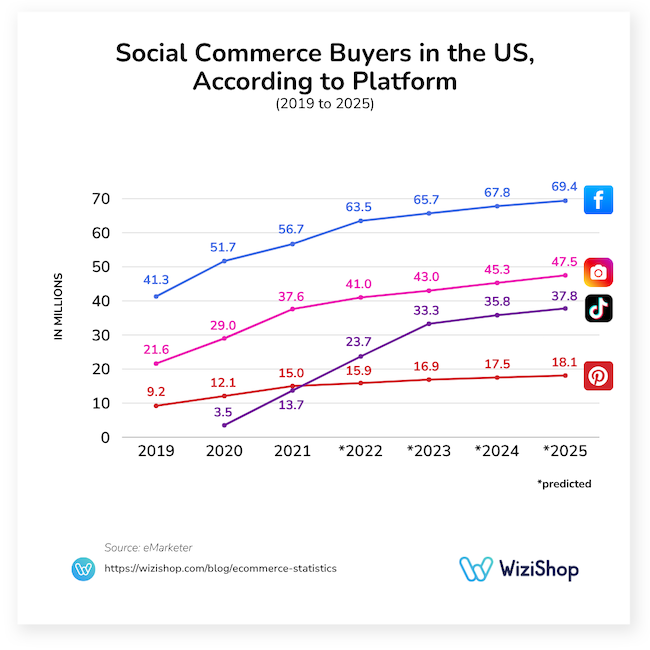
Instagram is also a popular choice, with 47.5 million consumers expected to purchase via the platform this year. This is followed by TikTok, with an estimated 37.8 million shoppers for the same period, and Pinterest, with an estimated 18.1 million shoppers.
62% of consumers will cease buying from brands that don’t provide a personalized experience
The importance of personalization in marketing is at an all-time high. In fact, delivering a personalized experience for each of your customers is likely to become a must in the future of ecommerce rather than just an option.
This is even more apparent when reviewing the results of a 2022 Statista study showing that the percentage of shoppers who stated that brands would lose their loyalty if they received an non-personalized experience increased from 45% to 62% in just one year!
There’s a 15% difference in the the level of personalization brands think they’re providing and what consumers think they’re receiving
Do you believe that you’re already taking full advantage of personalization in your digital marketing efforts?
Even so, it wouldn’t hurt to take another look at your strategy and maybe even reach out to your customers to see how you may be able to improve in this area.
A 2021 study by Twilio Segment discovered that despite 85% of businesses thinking they offered personalized experiences, only 60% of consumers were in agreement.
Ecommerce email marketing offers an average ROI of $45 for every dollar spent
Email marketing continues to be one of the most prevalent marketing strategies, as it usually provides a high return on investment (ROI) across the board, earning businesses an average of $36 per dollar spent. However, this amount surges 25% for ecommerce brands!
Note that although this digital marketing strategy is generally quite advantageous for online retailers, you can’t just write anything in your messages and expect to be successful with your efforts.
On average, consumers spend 10 seconds reading brand emails
Consumers tend to receive loads of emails every day, and they don’t always have the patience or the time to read each one carefully.
Statista data reports that the average amount of time that people spend reading a branded email once it’s been opened has decreased in recent years, going from 13.4 seconds in 2018 to 10 seconds in 2021.
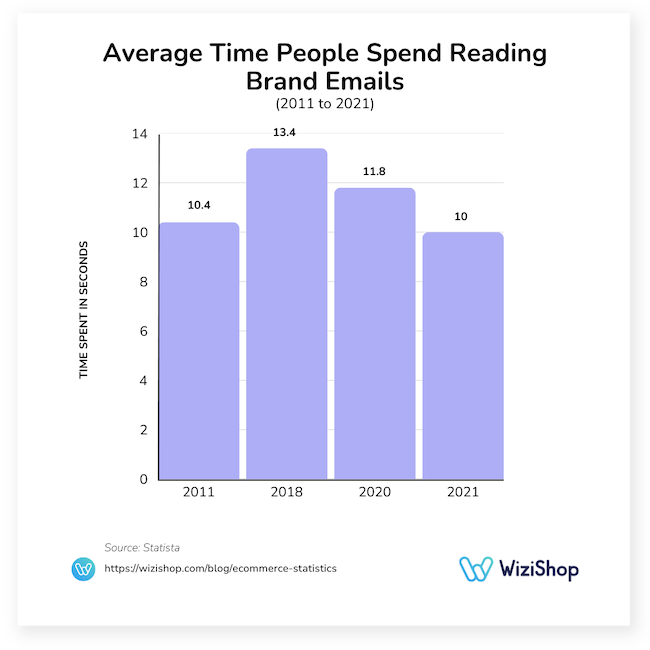
For this reason, it’s crucial to know your target audience and what kind of content is most likely to appeal to them.
Almost 50% of e-merchants in Europe and North America believe that implementing an omnichannel strategy is very important
Nowadays, consumers can buy from and communicate with their favorite brands in multiple ways, including in person at physical stores or online on ecommerce sites or social media platforms.
While many companies go the multichannel route to allow for as many sales opportunities as possible, an increasing number of them are recognizing the importance of taking an omnichannel approach.
In fact, Statista data shows that in 2021, 47% of ecommerce decision-makers based in Europe and North America considered omnichannel strategies to be very important.
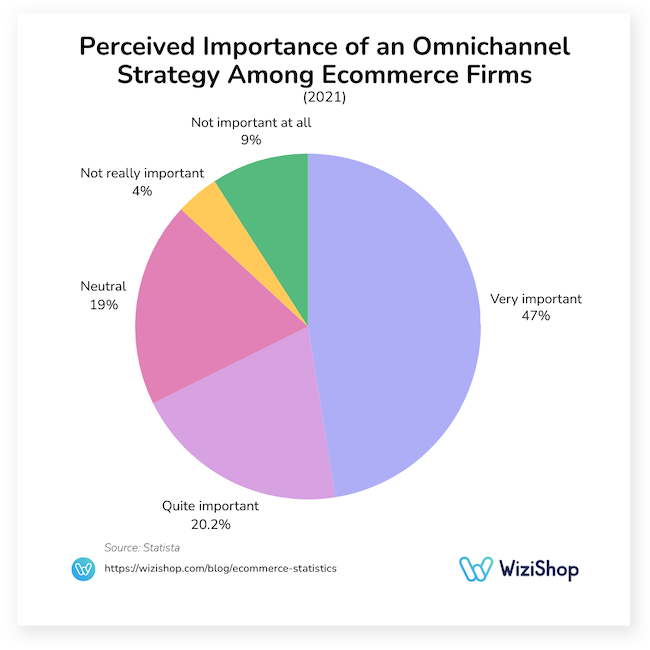
This method takes the multichannel strategy to the next level by ensuring that your various channels are integrated seamlessly, making it possible for you to optimize your communication with consumers and give a more personalized shopping experience for each customer.
When implemented well, an omnichannel strategy can do wonders for nurturing your relationships with prospective customers and boosting conversions.
Whether you have a brick-and-mortar shop in addition to an ecommerce version or strictly sell your products on the web, omnichannel marketing will help you to improve the shopping experience for users, boost customer satisfaction, and differentiate your brand from the competition.
Over half of ecommerce businesses are using AI technology to automate sales, marketing, and customer service
The use of artificial intelligence (AI) is becoming increasingly popular with e-merchants across the globe. In fact, 51% of them are already taking advantage of this kind of technology to facilitate various tasks associated with managing an online store and provide shoppers with an improved user experience.
Artificial intelligence is an impressive tool for online retailers, as it can help them to reduce operating costs, boost productivity, and make their businesses more competitive.
The WiziShop ecommerce solution is delighted to offer users an amazing new feature that allows them to harness the power of AI technology and optimize the writing of various types of content for their online stores. With this premium tool, you’ll be able to create high-quality product descriptions, translations, blog posts, ads, meta description, and more in a flash!
Try WiziShop free for 7 days
THE EASIEST NO-CODE ECOMMERCE SOLUTION✅ No credit card required
✅ Access to all features
✅ No commitment
Mobile commerce
Mobile commerce revenue is expected to surpass $2.5 trillion in 2025
The mobile commerce or m-commerce market has increased significantly in recent years and is predicted to experience growth of approximately 128% in the period between 2020 and 2025, amounting to over $2.5 trillion in global revenue.
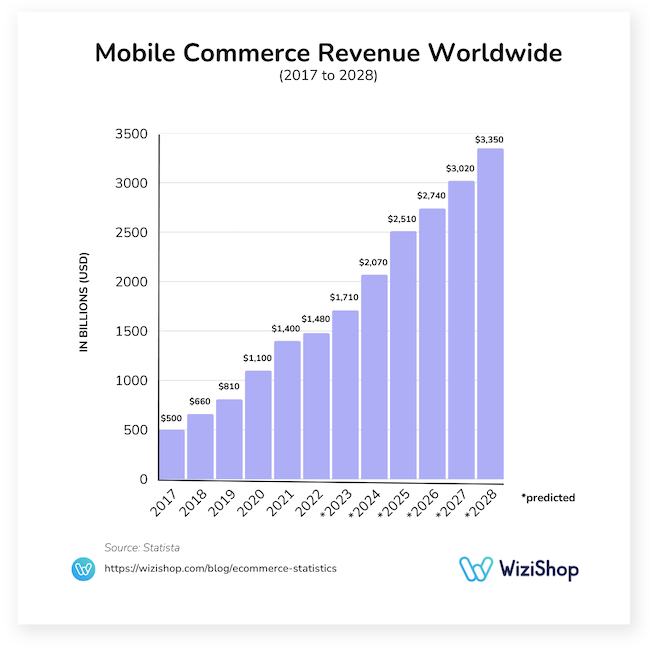
Mobile commerce is likely to continue growing in the future, with more than $3.3 trillion in revenue predicted in 2028.
Smartphones make up about 78% of retail website traffic
With over three quarters of global retail website traffic originating from mobile traffic and 68% of online sales orders coming from smartphones, one thing is clear: if you don’t already have a mobile-friendly version of your online store, the above statistic should help convince you to start working on this ASAP!
In addition, when you consider that the number of smartphone subscriptions around the world was over 6.7 billion in 2023 and that this figure is predicted to surpass 7.9 billion by 2028, it’s no wonder that consumers are increasingly using their mobile devices to shop on the web.
With a growing dependence on all the helpful features that smartphone technology offers, it’s unlikely that the majority of people are going to be giving up their beloved devices anytime soon.
Knowing these statistics, it's essential that you keep mobile commerce at the forefront of your strategy. Whether you’re about to launch your ecommerce business or already have one in place, prioritize providing an enjoyable mobile shopping experience for users shopping on your site.
The likelihood of bounces occurring rises 32% when mobile page load time increases from 1 second to 3 seconds
It’s no secret that today’s culture is one of instant gratification, and we’re provided with a plethora of online shopping options available at our fingertips.
Consumers therefore won’t hesitate to exit a website and head to a competitor’s if the page they’re currently on takes an extra few seconds to load. This can be even more frequent of an occurrence when they’re visiting the site from a mobile device.
Your online store’s bounce rate, or the percentage of site visitors who arrive on one of your pages and leave before checking out other pages, can be significantly impacted by your page loading speed.
While potential customers visiting your online store from a mobile device are more than 30% more likely to leave if a page take 3 seconds to load, the likelihood of them exiting your site increases dramatically with page loading times that are just a few seconds longer, as shown in the table below:
| Change in page load time | Increase (%) in probability of bounce |
|---|---|
| 1 second to 3 seconds | 32% |
| 1 second to 5 seconds | 90% |
| 1 second to 6 seconds | 106% |
| 1 second to 10 seconds | 123% |
Source: Google
A website that takes a long time to load can not only lead to visitors leaving your online store without making a purchase but also to your store dropping in the rankings on Google. This is due to the fact that the search engine rewards faster sites over slower ones.
To see where your online store currently stands in terms of page speed, don’t hesitate to check out Google’s PageSpeed Insights tool for an instant analysis.
Online shoppers’ behaviors and preferences
On average, approximately 70% of shopping carts are abandoned
If you’re concerned about your online store’s seemingly high cart abandonment rate, don’t throw in the towel and shut down your business just yet!
Most ecommerce sites see quite a few abandoned carts on a daily basis, with the average cart abandonment rate being 70.19%.
At first glance, this can be discouraging as a business owner, especially if you’ve devoted lots of time, energy, and possibly even money to driving more traffic to your site.
However, it’s important to keep in mind that shoppers may add items to your site and then leave before making a purchase for any number of reasons—some of which you may not be able to have much control over.
Nevertheless, you can always aim to improve your online store’s abandoned cart rate! As you’ll see below, a high abandoned cart rate is often due to causes that can be easily remedied.
The top reason for cart abandonment is extra costs that are too high
Although some people shopping on the internet are ready to make a purchase as soon as they find the product or service that they’re looking for, others are simply in the mood to browse—the online equivalent of window shopping!
Shoppers in the latter category are much more likely to exit an ecommerce site before finalizing an order. Maybe they wanted to do a bit more research or had to close the browser because something else came up unexpectedly.
That being said, for those consumers not in this “not-ready-to-buy” segment, there are several common reasons why they opt to abandon their shopping carts when visiting an online store, with the main concern being financially related.
A 2025 Baymard Institute study involving over 1,000 adults in the US found that the #1 cause for shoppers abandoning their carts at checkout was due to extra costs such as shipping, taxes, or fees being higher than expected, with 39% of respondents naming this as one of the reasons they’ve abandoned a cart in the past three months.
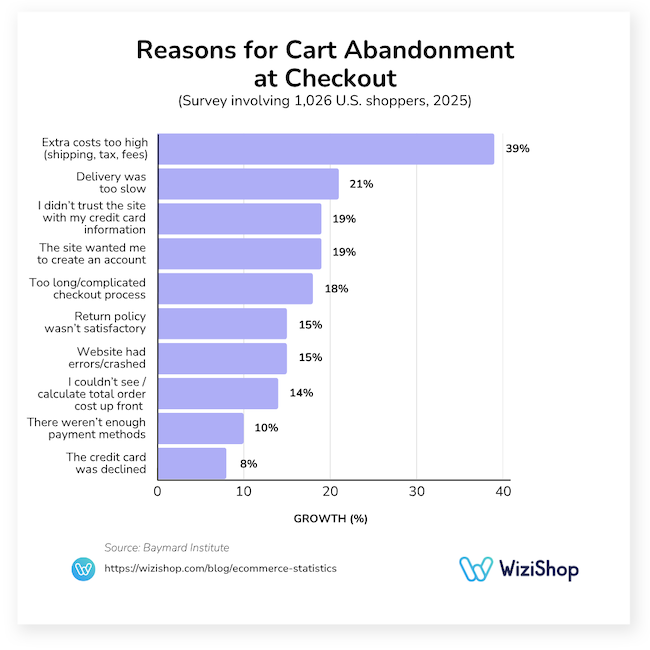
This was followed by slow delivery, distrust in providing the site with credit card information, and mandatory account creation.
To help with these concerns, try to minimize extra costs for your customers and be as up front as possible about required costs associated with shipping, taxes, or other fees.
In addition, allow visitors to check out as guests, offer the option to avail of fast shipping, and display security certificates you’ve obtained to boost consumer trust.
For 90% of consumers, free shipping is the main incentive to shop online
As hinted at in the previous statistic, people aren’t generally big fans of paying for shipping when purchasing items on the internet (shocker, I know).
However, knowing that it has a major impact on the buying decisions of 9 out of 10 shoppers will likely sway you to at least think about offering free shipping on your online store if you aren’t already doing so.
Don’t want to implement a policy allowing for no-cost shipping for every single order on your ecommerce site?
There are ways to work around this. For example, you might offer free shipping for orders over a certain dollar amount, slower delivery times, or customers enrolled in your loyalty program.
You can even help build your email list by gifting new subscribers with a discount code to use for free shipping on their next purchase!
89% of consumers have made at least minor changes toward purchasing more sustainable products in recent years
Although ecommerce offers quite a few advantages for both consumers and retailers, it comes with several disadvantages too, including wasteful excess packaging and rising carbon emissions from transporting orders.
With a growing concern for the environment and the negative effects of climate change, many online shoppers around the world are increasingly prioritizing sustainable goods for their purchases.
In a 2022 Statista survey, the majority (89%) of consumers stated that they’d begun engaging in more environmentally friendly purchasing behavior over the past 5 years, with 35% of respondents saying that they bought sustainable products significantly more frequently or changed their way of living around to be sustainable.
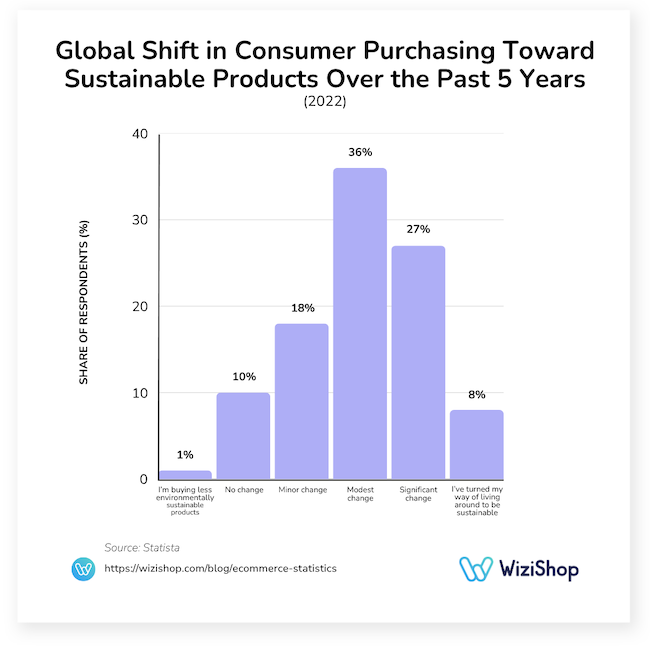
To appeal to eco-conscious consumers (and of course help the planet), brainstorm how your business can work on becoming more sustainable. This might involve your products themselves, your business practices, or a combination of the two.
It’s also interesting to note that data from a 2022 Statista study found that over 50% of consumers want to buy secondhand goods or fix the items they already have rather than purchase new items.
This suggests the perfect opportunity to launch that vintage clothing online store that you’ve been dreaming of starting!
Final thoughts
Depending on your specific products and target market, it’s possible that some of the ecommerce statistics discussed in this article may be more applicable to your business than others.
Nevertheless, this list of statistics serves as a helpful source of interesting insights into what’s occurring in ecommerce today and how the acts of buying and selling online are evolving.
Don’t have an ecommerce site yet but feeling inspired to get started? WiziShop has got you covered.
With our all-in-one ecommerce solution, you’ll be able to take advantage of free training on numerous topics related to online sales, over 400 pre-integrated features designed to increase your conversion rate, assistance from our friendly, knowledgeable team of Business Coaches, and much more.
Launch your ecommerce adventure by enjoying a 7-day free trial with WiziShop. It’s the perfect time to begin!
Try WiziShop free for 7 days
THE EASIEST NO-CODE ECOMMERCE SOLUTION✅ No credit card required
✅ Access to all features
✅ No commitment


